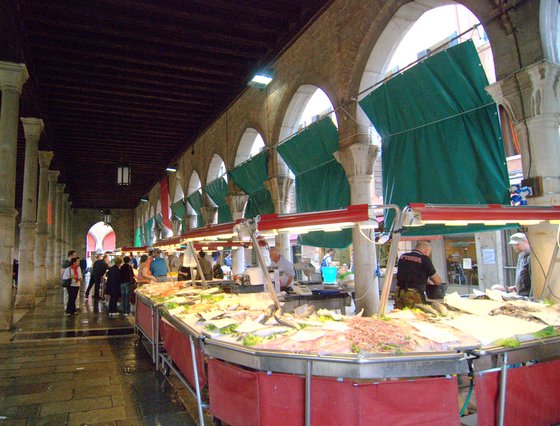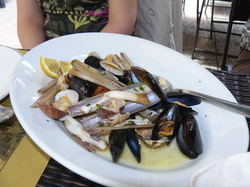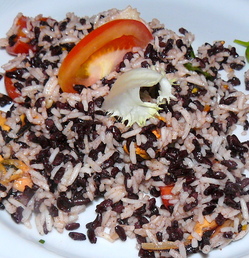An informal group of Seattle restaurants was again promoting wild Alaska salmon from Bristol Bay earlier this month, with the argument that eating salmon is the best way to protect the endangered salmon runs. Similarly, eating local shellfish in the Mediterranean provides a reliable demand for the shellfish growers.
 |
| Venetians shopping at the city's main fish market |
VENICE--The Mediterranean Sea -- under a million square miles, barely a mile deep -- is tiny compared to the world's great oceans. (The mighty Pacific is 65 times as vast, three times as deep.) It's as placid as a big lake, teeming with aquatic life -- 250 species of shellfish alone.
Along the Mediterranean coast of France, boats set out nightly to catch rockfish and eels for the local bouillabaisse, while oysters grow on the rocky reefs west of Marseille. Along the coast of Sicily, they go for prize swordfish, bluefin tuna, grouper, anglerfish, mullet, and sardines. Octopus and cuttlefish are everywhere. And in the northern Adriatic, where the Mediterranean dead-ends between the east coast of Italy and the west coast of Slovenia and Croatia, there's a thriving business cultivating shellfish (mussels, clams, oysters, scallops), especially in the shallow lagoons between Venice and Trieste.

Aurelio Zentilin.JPGWith a PhD in marine biology, Trieste-based Aurelio Zentilin runs the marketing arm of a thriving shellfish cooperative and writes an entertaining blog about mollusks. Fluent in Italian and French, he also hosts a YouTube series titled "Mollusk TV" that provides down-to-earth advice on selecting and cooking shellfish. Restaurant professionals regularly invite him to their gatherings, where he willingly shares his expertise and his recipes.
So let's start, as does Zentilin, at the retail fish markets of the Adriatic. The most active is in Venice: The Pescharia (officially known as il Mercato del Pesce al Minuto) on the Grand Canal, which has sheltered dozens of fishmongers in a red brick hangar alongside the Rialto bridge for centuries. If you find tourists here, they're snapping pictures of Venetians buying dinner. Caught in the surrounding waters: Squid, sardines, sea snails, and those shrimp-like creatures called canoce that Cornichon wrote about earlier in the year.
 |
| Razor clams at 40 Ladroni |
Where to go for the freshest shellfish? We told you about one spot, the Antiche Carampane, this summer. Here's another: the Osteria ai 40 Ladroni (40 Thieves), on a quiet canal of the Cannaregio. To get there, you first cross the Campo del Ghetto. That would be the original Ghetto, or slag-heap, considered the least desirable spot to live in Venice, all bright and shiny these days with a Jewish museum. Keep going. The spot you're headed for, on the Fondamenta della Sensa, is sought-after by locals because it's well outside the San Marco-Rialto-Academmia tourist triangle and serves dazzlingly fresh seafood.
Pay no heed to the tourist comments on TripAdvisor and similar sites. They'll never be happy unless it's cheap and deep-fried; the worthwhile comments are in Italian
("A chi piace il pesce e la cucina casalinga questo è un posto assolutamente da provare, noi non vediamo l'ora di ritornare!" which translates to, "If you like home cooking this is a spot you must try; we can't wait to return.") Shrimp with polenta, a perfect scallop in its shell, calamari, a sublime cod fritter, the sweetest razor clams imaginable. Not a tourist trap, for sure.
 |
| Risotto with Mussels at Terra & Laguna |
And one more spot, Zentilin's own favorite spot, Terra e Laguna. It's in Aquileia, a Roman crossroads that was once the second most important port in Italy. (Pope Benedict XVI stopped by to celebrate Mass in Aquileia's historic basilica six months ago.) Local white wines -- Riesling, Pinot Grigio -- are served slightly frizzante (tingling), as is customary. The clams and scallops are served raw; even the branzino from local waters comes out sashimi-style, dressed only with strawberries. Risotto with mussels and black rice is served cold.
The Adriatic, by the way, is the same temperature as Puget Sound, and a single mature mussel, Zentilin reminds me, filters 21 liters of 14-degree water a day -- over five gallons. Farmed shellfish, he's convinced, are the key to healthy waters, since they eat the same thing as shellfish in the wild. Compare that to farmed fin-fish, whose feed has to be imported, and whose waste has to be disposed of. And Zentilin's shellfish cooperative has the full support of the local government.
"There's a mutually beneficial relationship here between our shellfish industry and tourism," he says. Not American tourists, necessarily, but Germans above all. It's just a 300-mile hop across the Alps from Munich to the warm-water playground of the Adriatic, and Germans love mollusks.
Osteria Ai 40 Ladroni, Cannaregio 3253 (Fondamenta della Sensa), Venice, Italy (39) 041 715736
Terra e Laguna, via Minut 1, Aquileia, Italy (39) 0431 919444
 Two strands to this story. One is current, Rossella Rago's "Cooking With Nonna" website and TV show. The other is historic, involving Sicily and Garibaldi.
Two strands to this story. One is current, Rossella Rago's "Cooking With Nonna" website and TV show. The other is historic, involving Sicily and Garibaldi. So there we have it: potato gnocchi rolled out, flavored and cooked in the space of half an hour.
So there we have it: potato gnocchi rolled out, flavored and cooked in the space of half an hour.





